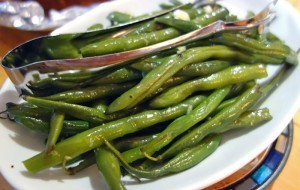
Originally posted on CookFearless.com
Years later, several participants in the project at the heart of The Kitchen Counter Kitchen School still say that the lesson on roasting vegetables was a game changer. “My kids will eat vegetables that have been roasted that they wouldn’t otherwise touch,” one of them said. “Plus, once you’ve cut them up and shove them in the oven, they pretty much cook themselves.”
Roasting concentrates and sweetens their flavor and transforms often disliked vegetables such as turnips and Brussels sprouts into sweeter, nuttier and mellower versions of their raw selves. In addition to its hands-free nature, as a bonus, most prep can be done ahead of time. Cut them up, store them in the fridge and pull them out when you’re ready to start dinner. Then all you have to do is toss them with oil and seasonings, spread them on a pan, and check on them occasionally until they’re done. (A few exceptions to the prep rule include those that will oxidize quickly and brown, such as potatoes.)
Easy ways to add flavor

Roasting gives vegetables enough extra flavor that they’re terrific to eat as is—maybe brightened with a dash of lemon juice. Want something more? Whip up a quick vinaigrette or toss with spices (such as this homemade Cajun seasoning) or a finishing butter infused with fresh herbs or a rosemary-thyme-lemon oil. See my Cheat Sheet to Flavor Profiles for more ideas.
In general, when flavoring roasted vegetables (particularly after roasting), avoid any seasoning that has too much liquid lest it soften any crisp edges that develop during roasting.
Four tips for successful roasting
Get your oven hot (450°F to 475°F). The vegetables cook quickly—many vegetables take only 20 minutes—but they still have a chance to brown nicely on the outside by the time they become tender inside. To increase the browning and speed up cooking, you can add your roasting pan or cookie sheet into a hot a oven and get it hot before you add the vegetables.
Aim for even cuts. Unevenly sized pieces won’t roast and brown in the same amount of time, and you’ll end up with both over-roasted and under-roasted vegetables.
Line the pan. To prevent sticking, line the pan with a sheet of parchment, foil or a silpat; otherwise. It eases clean-up and also assures you get all the tasty caramelized bits from the bottom.
Make use of the pan’s edges. Arrange pieces toward the edges of the pan; they’ll brown better.
If you need more servings than a single batch yields, you can easily double or triple these basic roasting recipes. Just don’t crowd the vegetables on the baking sheet—they won’t brown as well if they’re packed too closely. Ideally, there should be at least 1/2 inch between the pieces. Use another baking sheet if necessary and swap the sheets’ positions in the oven about halfway through the roasting time so that the vegetables will roast evenly.


 newest »
newest »
 newest »
newest »
 This is my favorite way to make and eat veggies! I often then toss them over a salad (ex: roasted beets over arugula with oranges and feta or goat cheese- yum!) or puree with some veg broth and seasonings - a quick, hearty delicious soup.
This is my favorite way to make and eat veggies! I often then toss them over a salad (ex: roasted beets over arugula with oranges and feta or goat cheese- yum!) or puree with some veg broth and seasonings - a quick, hearty delicious soup.







